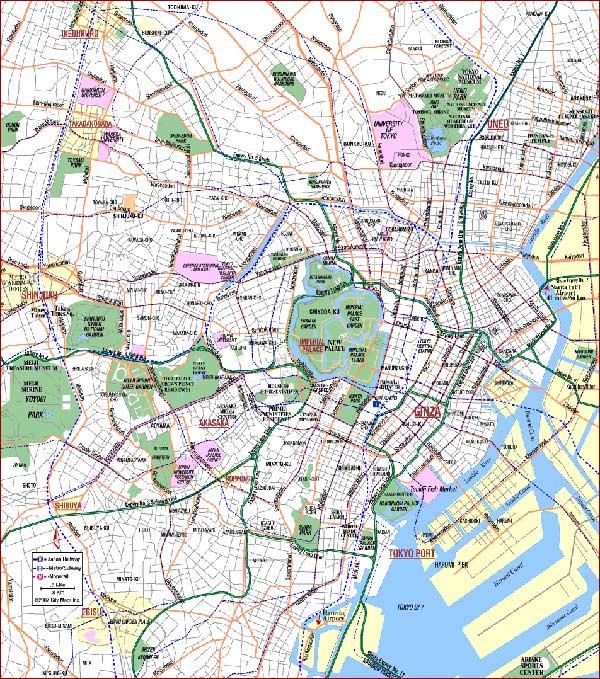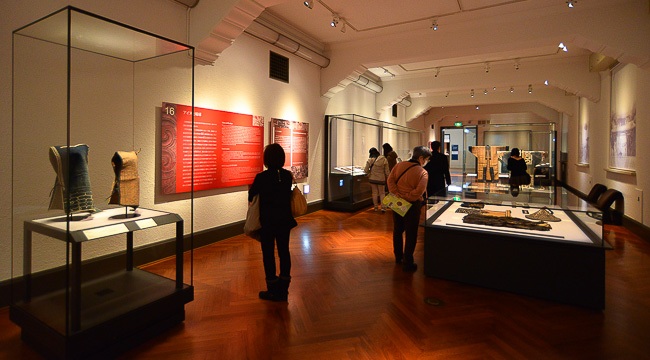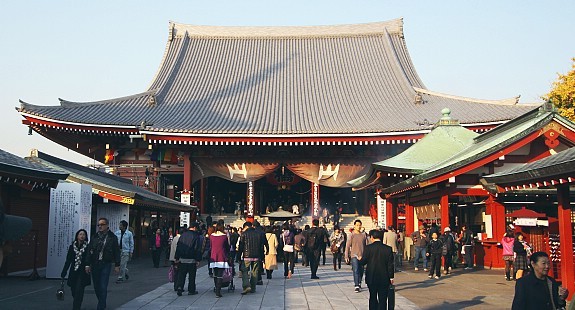
"Animated" is perhaps the best word to describe Tokyo. Crazy about its anime, Japan's mega city is constantly buzzing with movement – feet clacking down sidewalks, cars zooming along streets, subway trains humming below ground, ships cruising in and out. And yet bright lights and loud signs beg you to pause, to break your motion for just one second to pray (oops, we mean pay) at the altar of consumerism. This is a city that feeds on motion and progress.
But when you want to stop in Tokyo, the city will certainly make it worth your while. The tech-savvy locals may whizz past the monuments and urban parks daily (except during the cherry blossom season when everyone floods the green space), but, we assure you, the museums and historical sites are world-class. Here, there are photos to be taken, sushi to be eaten and a lot of shopping to be done. So what are you waiting for? You better get a move on.
Interesting Place In Tokyo
1.Tsukiji Market

Even if you're not a sushi connoisseur, the Tsukiji Market offers an unforgettable experience. It is the largest and oldest fish market in the world, handling upward of 1,800 tons of seafood per day. Ships arrive in the wee hours of the morning, and by 5 a.m., the famous tuna auctions have already commenced with wholesalers bidding for good-looking specimens. Unfortunately, due to the increased number of tourists, these exciting auctions are closed to the public, except for a small viewing area open from 5 to 6:15 a.m. While we encourage early risers to queue for this small space, the rest of the market, which always welcomes visitors, is sufficient to whet your appetite.
Nearly 500 different types of seafood are sold here, ranging from basics (like tuna) to the exotic, as well as the high priced (a box of uni, or the edible part of a sea urchin, is $250 per box). If all the excitement and bartering starts to make you a little hungry, don't hesitate to grab a bite here. There are numerous sushi stalls and tiny restaurants in the market (Sushi Dai and Daiwa Sushi are popular spots) that serve fish at their freshest. But if you aren't a much of a seafood fan, no matter. There's still something for you here. The market also sells loads of produce (about 270 different types) and features a few ready-made meal stalls that aren't all seafood-based, including Mosuke Dango, where you'll find sweet dumplings. There's also Indo Curry Nakaei, which serves curry. Plus, the nearby outer market offers a series of streets filled to the brim with restaurants and cafes that feature a vast array of delectable cuisines.
Travelers had mixed reviews on the famed Tsukiji Market. If you're not at all a seafood person, or you really don't like overstimulating and/or crowded places, visitors say this is not the attraction for you. Travelers say this market is huge and very busy all hours of the day. Those who do enjoy seafood will no doubt be in awe of the vast array of fresh and delectable seafood options available, so much so that patrons strongly suggest coming hungry as you'll probably end up eating more than you planned. Travelers also delighted in the market's lack of a pungent, fishy smell.
The Tsukiji Market is located in the center of Tokyo in the Chuo neighborhood. If you're taking public transit, you should get off at the Tsukiji or Tsukijisjijo metro stations that surround the market. The market is open for business every day of the week except Sunday and Wednesday; for the most activity, visit in the morning. If you want to watch the live tuna auction, you must get tickets at the Fish Information Center (located by the Kachidoki Bridge entrance) at 4:30 a.m. when they become available. Spots are on a first come, first serve basis and only 120 people are permitted to witness the tuna auction each day. Hours are 10 a.m. to 2 p.m. Because the market is so dense and busy, children are not permitted.
2.Tokyo National Museum

If you're looking to learn a little (or a lot) about Japan's history, the Tokyo National Museum is the place to go. This museum is one of the country's most expansive, housing about 116,000 pieces of art and artifacts that cover the longest recorded history of Japan. Strolling through the halls of its numerous buildings, you'll spot relics such as samurai armor and swords (a traveler favorite), delicate pottery, kimonos, calligraphy, paintings, and much more, some of which are designated as national treasures and Important Cultural Properties by the Japanese government. In addition to artifacts from Japan's history, you'll also find pieces from all across the Asian continent, including Buddhist scrolls that date all the way back to 607.
Travelers were impressed with all that the Tokyo National Museum has to offer. Even some who admitted they aren't museum people enjoyed the variety of unique artifacts on display. Travelers appreciated that the museum featured English translations, something that some visitors noticed other Tokyo top attractions lacked (think the Ghibli Museum). Museum goers also say that there so much to see in the Tokyo National Museum that you probably need an entire day if you want to get through everything. If you don't have enough time to do this (or just don't want to) the best thing to do is get a map of the museum beforehand and pick what you want to do before you venture in.
The Tokyo National Museum is easily reached on the metro. The closest metro stops are Uguisudani and the Ueno metro station. Be sure to enjoy the fresh air of the surrounding Ueno Park before or after you visit the museum. The park also features a zoo, the National Museum of Nature and Science, the National Museum of Western Art, a scenic pond equipped with row boats and plenty of verdant green space. Admission to the museum costs 620 yen (about $6) for adults. The museum welcomes visitors from 9:30 a.m. to 5 p.m. every day except Mondays, when it is closed.
3.Sensoji Temple

The oldest religious site in Tokyo is also its most visited. The Sensoji Temple sees about 30 million annual visitors and dates all the way back to year 628. Despite its claim to antiquity, however, the structures that currently stand are relatively new reconstructions of previous edifices (during World War II, nearly the entire temple was razed). The Sensoji Temple is dedicated to Asakusa Kannon, the Buddhist god of mercy and happiness. According to legend, two fishermen struck gold and found a statue of the god while fishing on the Sumida River. The Sensoji shrine is dedicated to this lucky catch as well as features a small homage to the fisherman who caught the statue. Unfortunately, while here, you won't be able to see the actual statue. It is there, but it isn't on public display. It has never been. Either way, Buddhists and interested tourists alike flock to this attraction with the hopes that being in the presence of Kannon's healing powers will rub off on them. After you've properly toured Sensoji, take some time to check out the shops that line Nakamise Dori, which you'll find on the way to the temple.
The majority of travelers enjoyed their experience at the Sensoji Temple. Visitors found the temple to be beautiful and enjoyed admiring its grand stature and intricate architectural details. The only complaint among travelers was with the attraction and all the activity surrounding it; Sensoji can get so crowded that it can be difficult to be able to simply admire the attraction. If you don't want to share space with throngs of tourists, visitors suggest coming early morning or late at night.
The Sensoji Temple is easily accessed via the Asakusa Station. Although the temple grounds remain open 24/7, the main hall welcomes visitors daily from 6 a.m. to 5 p.m. From October to March, the hall opens a bit later at 6:30 a.m. Admission is free.
4.Imperial Place

You'd think the Imperial Palace would be mobbed with tourists, but it's not. You can credit the lack of crowds to an application policy, which limits the number of visitors. That's because the Imperial Palace is home to the Emperor of Japan and the royal family. And before that, it was the residence for some of Japan's most important figures, including Emperor Meiji (credited for modernizing Japan) and rulers during the Edo Period (the time period before Japan was modernized by Meiji). Because of its significant importance in Japanese society, admittance to the site is hard to get (you have to put in your application several weeks in advance) and access inside the actual palace is even fewer and far between.
As such, most travelers suggest skipping the application entirely (those who went on the tour were disappointed with how little of the palace is open to visitors) and admiring the compound from afar. Visitors also say the East Gardens, which are part of the Imperial Palace complex, are much more of a sight to see. This flourishing green space has plenty of shady spots and open fields, perfect for relaxing. And during cherry blossom season, these gardens are a choice spot for locals looking to enjoy the seasonal foliage.
Visitors are free to explore the East Gardens anytime between 9 a.m. and 4:30 p.m. The park closes a half hour earlier during the winter and a half hour later during the summer. Tours of the palace are given at 10 a.m. and 1:30 p.m. Tuesday through Saturday and they usually last one hour and fifteen minutes. The closest metro station is Nijubashi-mae station.
That all for today, Thank You for read and don't forget to comments :)





No comments:
Post a Comment